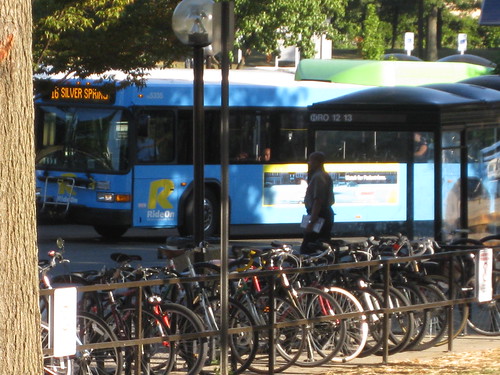The Treasury Department issues a report, A New Economic Analysis of Infrastructure Investment, that argues in favor of expanding transportation options as an avenue for economic growth, citing research on location-efficient neighborhoods and emission reductions due to transit ridership, among other evidence. Also covered is what the Administration is doing currently in terms of investments in infrastructure and speeding project delivery.
The report also speaks in favor of a national infrastructure bank and benefits to the middle class of wise infrastructure investment, including a benefit to Lincoln, NE, of 1000 jobs for making Metro North train cars that seat commuters from Westchester and Connecticut traveling into the city each day. (Yes, New York City, Grand Central, specifically.)
No Pie on Transit* - Except Pi Day?
Public health benefits are touted as a reason to invest in transit.
Using data on individuals before (July 2006 to February 2007) and after (March 2008 to July 2008) the completion of a light rail system in Charlotte, North Carolina, they find that the use of light rail to commute to work is associated with a nearly 1.2 point reduction in body mass index as well as an 81 percent reduction in the odds of becoming obese. Moreover, improved perceptions of neighborhoods as a result of the availability of light rail were associated with 15 percent lower odds of obesity as well as higher odds of meeting weekly recommended physical activity levels for walking and vigorous exercise (9 percent and 11 percent, respectively).
In addition to all of the personal benefits associated with a healthier life style, overall costs on our health care system are substantially reduced when obesity rates are lowered, given that health care costs for the obese are almost twice the rate for normal weight individuals. Finkelstein et al. find that between 1998 and 2006, the prevalence of obesity in the United States increased by 37 percent, adding $40 billion dollars to health care costs.
A separate study by Stokes et al. estimates that health care savings in Charlotte from the creation of the first segment of their light rail system could reach a cumulative $12.6 million by 2015. These facts also suggest that targeted investment in creating new public transportation systems could translate into large-scale savings in health care costs. Furthermore, many other academic studies show that proximity to public transportation and more rationally-designed neighborhoods tend to be associated with increased walking and other physical activity for the general population, working or otherwise. [Footnotes omitted.]
Transit ridership growth is declared as well as increased demand for transit service. There is more in the report.
* [For all of you non-math nerds, Pi Day is March 14, as in 3.14159 etc., used in circle radius, circumference, diameter and other calculations. It is also the birthday of Albert Einstein and my mother. That would make her happy. Some schools ask parents to make pie donations for math class celebrations. Not that math classes are unhealthy; other than the last day of the term, that's pretty much the only day for less-than-healthy eating in algebra, geometry, trigonometry, calculus and beyond classes. Well, at least the ones I am aware of.]
Occupy Transportation? and State Updates
Amalgamated Transit Union
ATU is generating attention for April 4 as a National Day of Action for Public Transportation, called by Occupy Boston on the anniversary of Martin Luther King's speech about Vietnam and American poverty. The April 4 event "is about demanding public transportation for the 99% by spreading the word about the mass transit crisis out to riders and the general public." Occupy Boston voiced its concerns for transit funding at a recent public hearing. ATU's website links to the Occupy Boston announcement.
National Conference of State Legislatures
NCSL releases its monthly transportation newsletter, which includes an overview of reauthorization activity in Congress, high-speed rail developments, and an update on state funding for transportation.


